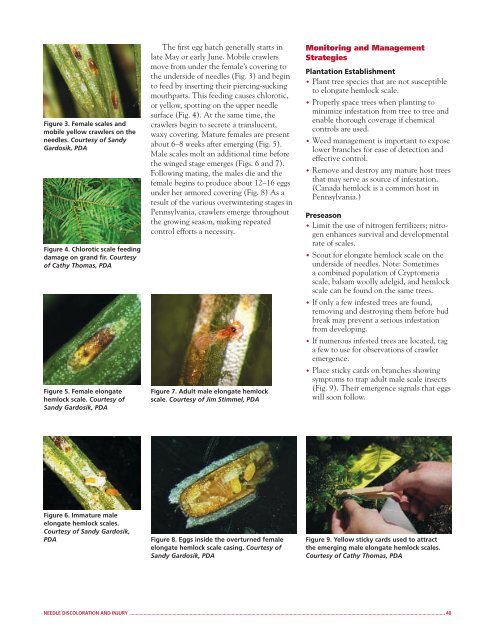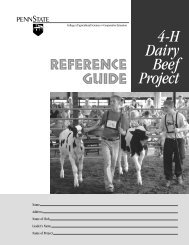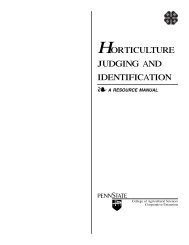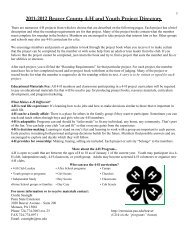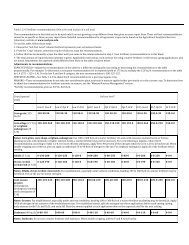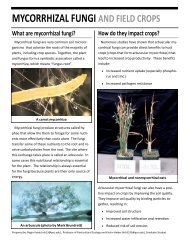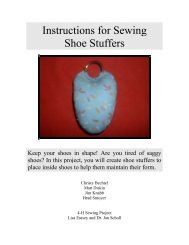Elongate Hemlock Scale - Penn State Extension
Elongate Hemlock Scale - Penn State Extension
Elongate Hemlock Scale - Penn State Extension
You also want an ePaper? Increase the reach of your titles
YUMPU automatically turns print PDFs into web optimized ePapers that Google loves.
Figure 3. Female scales andmobile yellow crawlers on theneedles. Courtesy of SandyGardosik, PDAFigure 4. Chlorotic scale feedingdamage on grand fir. Courtesyof Cathy Thomas, PDAFigure 5. Female elongatehemlock scale. Courtesy ofSandy Gardosik, PDAThe fi rst egg hatch generally starts inlate May or early June. Mobile crawlersmove from under the female’s covering tothe underside of needles (Fig. 3) and beginto feed by inserting their piercing-suckingmouthparts. This feeding causes chlorotic,or yellow, spotting on the upper needlesurface (Fig. 4). At the same time, thecrawlers begin to secrete a translucent,waxy covering. Mature females are presentabout 6–8 weeks after emerging (Fig. 5).Male scales molt an additional time beforethe winged stage emerges (Figs. 6 and 7).Following mating, the males die and thefemale begins to produce about 12–16 eggsunder her armored covering (Fig. 8) As aresult of the various overwintering stages in<strong>Penn</strong>sylvania, crawlers emerge throughoutthe growing season, making repeatedcontrol efforts a necessity.Figure 7. Adult male elongate hemlockscale. Courtesy of Jim Stimmel, PDAMonitoring and ManagementStrategiesPlantation Establishment• Plant tree species that are not susceptibleto elongate hemlock scale.• Properly space trees when planting tominimize infestation from tree to tree andenable thorough coverage if chemicalcontrols are used.• Weed management is important to exposelower branches for ease of detection andeffective control.• Remove and destroy any mature host treesthat may serve as source of infestation.(Canada hemlock is a common host in<strong>Penn</strong>sylvania.)Preseason• Limit the use of nitrogen fertilizers; nitrogenenhances survival and developmentalrate of scales.• Scout for elongate hemlock scale on theunderside of needles. Note: Sometimesa combined population of Cryptomeriascale, balsam woolly adelgid, and hemlockscale can be found on the same trees.• If only a few infested trees are found,removing and destroying them before budbreak may prevent a serious infestationfrom developing.• If numerous infested trees are located, taga few to use for observations of crawleremergence.• Place sticky cards on branches showingsymptoms to trap adult male scale insects(Fig. 9). Their emergence signals that eggswill soon follow.Figure 6. Immature maleelongate hemlock scales.Courtesy of Sandy Gardosik,PDAFigure 8. Eggs inside the overturned femaleelongate hemlock scale casing. Courtesy ofSandy Gardosik, PDAFigure 9. Yellow sticky cards used to attractthe emerging male elongate hemlock scales.Courtesy of Cathy Thomas, PDANEEDLE DISCOLORATION AND INJURY ................................................................................................................................................................................................................................................ 40


